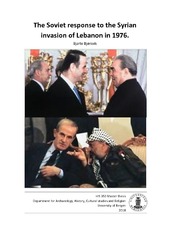| dc.description.abstract | On 1 June 1976, Syrian army units rolled into Lebanon during the Lebanese Civil War. They fought against the Palestinian Liberation Organization (PLO) and the left-wing Lebanese National Movement (LNM). Both Syria and the PLO were important clients of the Soviet Union (USSR), which was locked in a Cold War competition with the USA. The Soviet leadership became critical of the invasion and asked the Syrians to withdraw. However, Syria kept on fighting and only agreed to a ceasefire after Saudi Arabian mediation in October 1976. The Soviet-Syrian relationship was normalized in April 1977 when the Syrian president visited Moscow. This thesis investigates the Soviet response to the Syrian invasion of Lebanon from June 1976 to April 1977, and details why it reacted the way it did. Existing scholarship disagrees about whether the USSR knew about and supported the invasion. There are also different views about how much political, diplomatic, military and economic pressure Moscow exerted towards the Syrian regime. WikiLeaks and CIA documents from the period are used to shed new light on this very tense period in Soviet-Syrian relations. Patron-client theory, focusing on the patron’s goals and the client’s threat level, is applied to analyse the Soviet-Syrian relationship. The USSR had political and strategic goals to keep Syria as a client. The Kremlin did not support the Syrian invasion; nevertheless, it was afraid Syria would shift side in the Cold War. Seeing the superpower struggle as a zero-sum-game, such a loss was unacceptable for the USSR. Syria on the other hand was dependent on the USSR for military support, but its military threat level was low during 1976-77, and this increased Damascus’s influence over Soviet policy. In addition, Syria relied more on the Arab Gulf States than the USSR for economic aid. The Soviet leaders put a political, diplomatic, military and economic pressure on Damascus. To not lose Syria as a client, the pressure was limited. Meanwhile, to keep the PLO as an independent client, Moscow gave a restrained support to the PLO-LNM by political, diplomatic and military measures, directly and through Egypt, Iraq and Libya. By backing the PLO-LNM’s attempt to gain power in Lebanon by force, the Soviet strategy is seen as offensive. The PLO-LNM was weakened by the Syrian invasion, and the USSR’s policy was not successful. However, the USSR maintained Syria as a client. | en_US |
